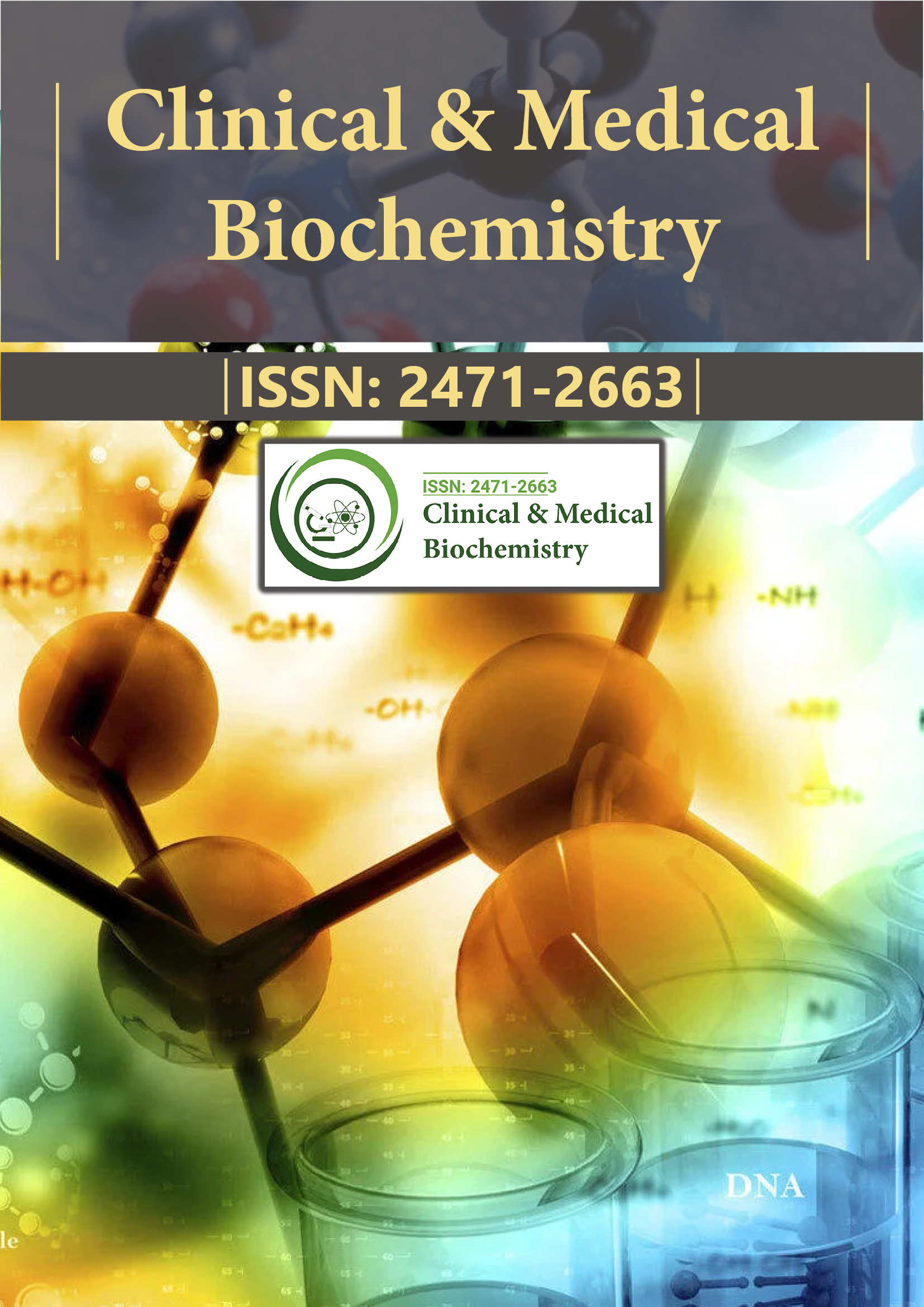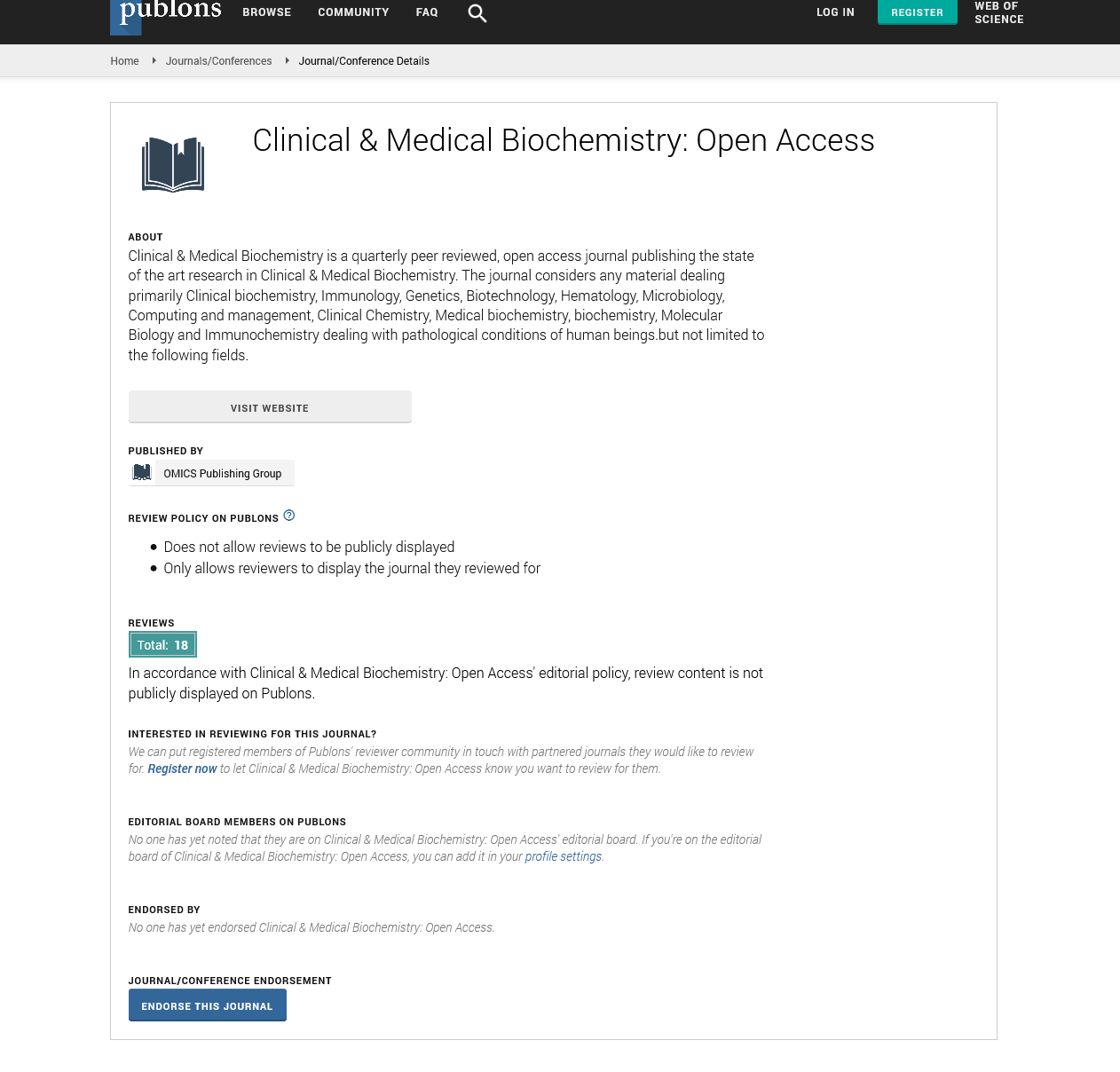Indexed In
- RefSeek
- Directory of Research Journal Indexing (DRJI)
- Hamdard University
- EBSCO A-Z
- OCLC- WorldCat
- Scholarsteer
- Publons
- Euro Pub
- Google Scholar
Useful Links
Share This Page
Journal Flyer

Open Access Journals
- Agri and Aquaculture
- Biochemistry
- Bioinformatics & Systems Biology
- Business & Management
- Chemistry
- Clinical Sciences
- Engineering
- Food & Nutrition
- General Science
- Genetics & Molecular Biology
- Immunology & Microbiology
- Medical Sciences
- Neuroscience & Psychology
- Nursing & Health Care
- Pharmaceutical Sciences
Perspective - (2023) Volume 9, Issue 5
Analysing Treatment Strategies for Diabetic Cardiomyopathy Using Innovative Medicine Approaches
Rodnei Tavares*Received: 01-Sep-2023, Manuscript No. CMBO-23-23084; Editor assigned: 04-Sep-2023, Pre QC No. CMBO-23-23084 (PQ); Reviewed: 18-Sep-2023, QC No. CMBO-23-23084; Revised: 25-Sep-2023, Manuscript No. CMBO-23-23084 (R); Published: 02-Oct-2023, DOI: 10.35841/2471-2663.23.9.188
Description
Cardiovascular diseases remain a leading cause of mortality worldwide, and among these, Diabetic Cardiomyopathy (DCM) presents a significant challenge. DCM is a distinct form of heart disease that develops in individuals with diabetes, independent of other known cardiovascular risk factors. It is characterized by structural and functional changes in the heart, including hypertrophy, fibrosis, and impaired contractility, leading to heart failure. The key features of DCM include left ventricular hypertrophy, interstitial fibrosis, inflammation, oxidative stress, and impaired diastolic and systolic function. It typically occurs in patients with long-standing diabetes, regardless of whether they have other risk factors such as hypertension or hyperlipidemia. Fibroblasts cells play a pivotal role in the development of interstitial fibrosis, a distinctive feature of DCM. Fibroblasts become activated in response to various stimuli, including hyperglycemia, inflammation, and mechanical stress. Upon activation, they differentiate into myofibroblasts, which are contractile and secrete extracellular matrix proteins, such as collagen, leading to fibrosis.
Understanding the molecular mechanisms that regulate fibroblast activation and their interactions with other cell types in the diabetic heart is critical for developing targeted therapies. The immune system also plays a substantial role in DCM. Inflammatory processes are activated in response to chronic hyperglycemia, leading to the advancement of immune cells to the heart. Macrophages, T cells, and neutrophils have all been connected in DCM pathogenesis. These immune cells release pro-inflammatory cytokines and chemokines, increase cardiac inflammation and tissue damage. Additionally, the immune response can contribute to oxidative stress, an important factor of DCM. The accurate roles of different immune cell populations and their interactions in DCM is essential for developing immunomodulatory therapies. Endothelial cells line the inner surface of blood vessels and play a vital role in maintaining vascular function. Dysfunction of endothelial cells is a common feature of diabetes and is closely linked to the development of cardiovascular complications, including DCM. Impaired endothelial function can lead to reduced nitric oxide production, increased oxidative stress, and altered angiogenesis, all of which contribute to DCM pathogenesis. In the context of diabetes, pericyte dysfunction can lead to microvascular rarefaction and impaired tissue perfusion, contributing to cardiac damage.
Adipocytes, on the other hand, can secrete adipokines that promote inflammation and fibrosis in the diabetic heart. The activation of cardiac fibroblasts in DCM is a complex process regulated by multiple signaling pathways. Transforming growth factor-beta (TGF-β) is an important factor in fibroblast activation, promoting their differentiation into myofibroblasts and collagen synthesis. Other signaling molecules, such as connective tissue growth factor (CTGF), and various cytokines also contribute to fibroblast activation and fibrosis. Targeting these pathways represents a potential therapeutic approach to enhance fibrosis and preserve cardiac function in DCM. Immune cell-mediated inflammation is a central feature of DCM, driven by the activation of inflammatory signaling pathways. Nuclear factorkappa B (NF-κB), a transcription factor, is a key regulator of proinflammatory gene expression in immune cells. Inhibition of NF- κB and other inflammatory signaling pathways has shown potential in preclinical models as a means to reduce cardiac inflammation and prevent DCM progression.
Endothelial dysfunction in DCM is linked to impaired Nitric Oxide (NO) bioavailability, increased oxidative stress, and altered endothelial cell signaling. The endothelial Nitric Oxide Synthase (eNOS) pathway, responsible for NO production, is disrupted in diabetes. Therapies aimed at renewing eNOS function and NO levels hold potential for improving vascular health in DCM. For instance, fibroblasts can interact with immune cells to modulate the inflammatory response, and endothelial dysfunction can promote fibrosis through paracrine signaling. Understanding these complex interactions is essential for developing comprehensive strategies to target multiple cell types simultaneously. Murine models have been instrumental in advancing our understanding of DCM and the contributions of cardiac non-myocytes to the disease. Commonly used models include genetically engineered mice with diabetes (e.g., db/db or Akita mice) and diet-induced obesity models. Murine models offer several advantages, including genetic manipulability, relatively low cost, and the ability to study specific cell types or signaling pathways. However, there are limitations, such as differences in cardiac anatomy and physiology compared to humans. Inhibiting cardiac fibrosis is a potential therapeutic strategy for DCM.
Clinical trials evaluating the effectiveness of these agents in DCM patients are ongoing. Immunomodulatory therapies aim to enhance cardiac inflammation in DCM. Immune celltargeted therapies, such as anti-inflammatory cytokine inhibitors and immunomodulatory drugs, are under investigation. Additionally, lifestyle interventions, like exercise and dietary changes, may help modulate the immune response in diabetic individuals. Preserving endothelial health is essential for preventing vascular complications in DCM. Medications that enhance NO production, such as nitrite or nitrate supplementation, and endothelin-1 receptor antagonists, are being explored as potential treatments. Lifestyle modifications, including improved glycemic control and physical activity, also support endothelial health. The heterogeneity of DCM presentation and progression suggests that personalized medicine approaches may be beneficial. Biomarker identification and risk stratification can help modify treatment strategies to individual patients, targeting the specific cellular and molecular mechanisms driving their disease. To gain a comprehensive understanding of the cellular and molecular landscape of cardiac non-myocytes in DCM, multi-omics approaches, including genomics, transcriptomics, proteomics, and metabolomics, should be involved. These techniques can identify novel therapeutic targets and biomarkers.
Conclusion
Diabetic cardiomyopathy is a complex and multifaceted disease, with a growing recognition of the roles played by cardiac nonmyocytes in its pathogenesis. Fibroblasts, immune cells, endothelial cells, pericytes, and adipocytes collectively contribute to the cellular and molecular view of DCM. Understanding the complex interactions and signaling pathways involved in these non-myocyte populations is essential for the development of targeted therapies. Advances in experimental models and multiomics approaches offer potential for discovering novel therapeutic targets and biomarkers. Ultimately, a comprehensive understanding of the cellular and molecular view of cardiac nonmyocytes in DCM will lead to more effective treatments and improved outcomes for patients with this challenging condition.
Citation: Tavares R (2023) Analysing Treatment Strategies for Diabetic Cardiomyopathy Using Innovative Medicine Approaches. Clin Med Bio Chem. 9:188.
Copyright: © 2023 Tavares R. This is an open-access article distributed under the terms of the Creative Commons Attribution License, which permits unrestricted use, distribution, and reproduction in any medium, provided the original author and source are credited.

